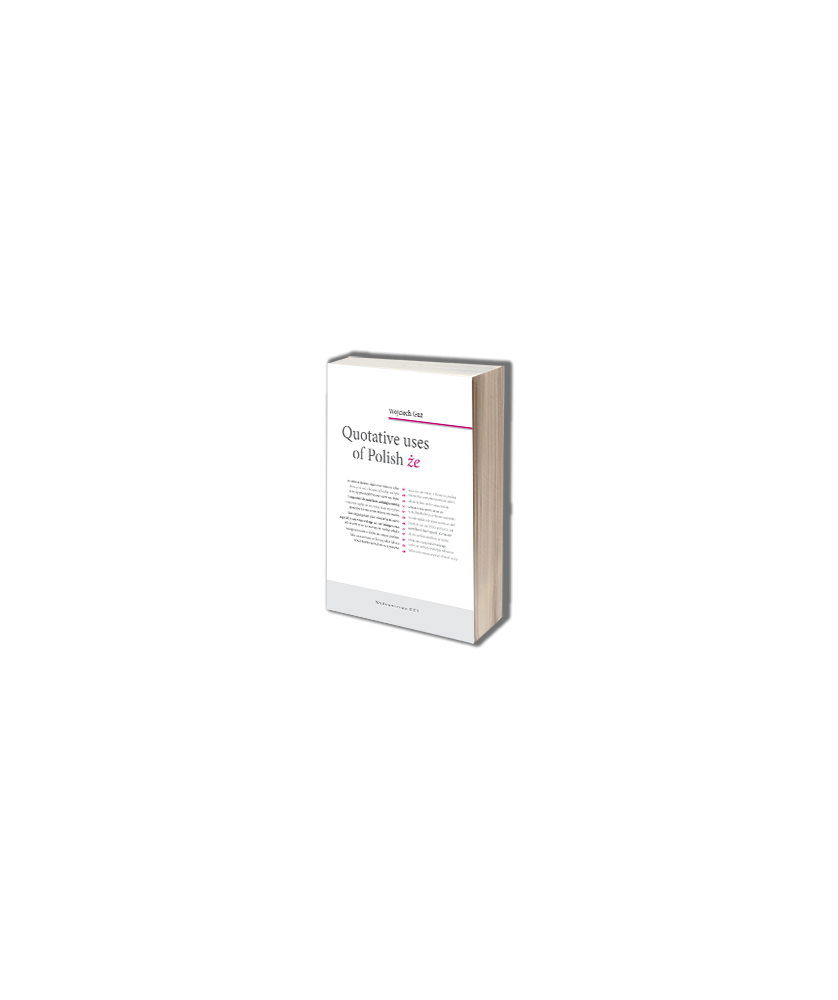
Quotative uses of Polish że
Wojciech Guz
ISBN: 978-83-8061-681-3
Stron: 242
Format: B5
Rok wydania: 2019
CONTENTS 
 
Abbreviations
Acknowledgements
Introduction
Chapter 1: Direct quotation in Polish and cross-linguistically
1.1 Introduction
1.2 Introduction to direct quotation 
1.3 Cross-linguistic overview of quotation strategies 
1.4 The repertoire of quotation strategies in Polish 
1.4.1 The purpose 
1.4.2 The corpus, data, and data collection 
1.4.3 Results and discussion 
1.5 Summary 
Chapter 2: Teasing the quotative and the complementizer apart 
2.1 Introduction 
2.2 Brief overview of Comp 
2.3 Function: direct quotation vs. indirect reporting 
2.4 Function: że-quotation as constructed discourse 
2.5 Function: quoting speech acts vs attaching complement clauses
2.6 Function: focus and dramatization
2.7 Distribution: absence of the head 
2.8 Distribution: optionality of Quot 
2.9 Do Quot and Comp overlap in their functions? 
2.10 Compatibility of Quot with co-text to the right 
2.10.1 Quot + wh-question words 
2.10.2 Quot + complementizers 
2.10.3 Quot + other types of że 
2.10.4 Quot + non-clausal material
2.10.5 Quot + non-lexical material
2.11 Compatibility of Quot with co-text to the left
2.11.1 Desiderative predicates + Quot
2.11.2 Gerund-taking predicates + Quot
2.11.3 Non-complementation predicates + Quot
2.12 Summary
Chapter 3: Verbless or verb-elided quotative constructions?
3.1 Introduction
3.2 VDR-ellipsis and (Conj) NP (Quot)
3.3 Is (Conj) NP (Quot) a result of gapping? 
3.3.1 Identity relation 
3.3.2 Coordination and parallelism 
3.3.3 Locality effects
3.3.4 Voice mismatches 
3.3.5 Symmetric and asymmetric readings
3.3.6 Case-matching 
3.3.7 Constituency of remnants 
3.3.8 Interim summary 
3.4 Null verbs (Marušič and Žaucer 2005, 2006) 
3.5 Slavic omission of verbs of action
3.6 (Conj) NP and English copula-based formula  
3.7 VDR-ellipsis and constructed discourse 
3.8 VDR-ellipsis and PAAVs  
3.9 Conclusion 
Chapter 4: A diachronic perspective 
4.1 Brief notes on the history of Comp 
4.2 Introductory notes on the history of Quot
4.3 A study of 15th-century iż(e)-quotation 
4.3.1 The corpus 
4.3.2 Verba dicendi and speech-related nominals 
4.3.3 Quotative and clitic host
4.3.4 More variation in form: iże, iż, iżci 
4.3.5 Interim conclusion 
4.4 A study of 16th-century Ż-quotation 
4.4.1 The corpus 
4.4.2 Formal variation: 15th vs. 16th centuries 
4.4.3 Patterns of use: verba dicendi and beyond
4.4.4 Causal iż(e)/iżci
4.5 Ż-quotation after 1600 
4.6 Conclusion
Chapter 5: Neutralization of contrast and cline of functions 
5.1 Introduction
5.2 Comp and Quot: cases of analytical ambiguity
5.3 Mixed direct/indirect speech reports
5.4 Że as a multifunctional introducer of clauses 
5.4.1 Relativizer
5.4.2 Adverbializer
5.4.3 Marker of elaboration/reformulation/explanation
5.4.4 Hedge, filler and interpretive marker uses
5.5 Comp and Quot sharing the meaning of ‘elaboration’
5.6 Summary
Conclusion
References


